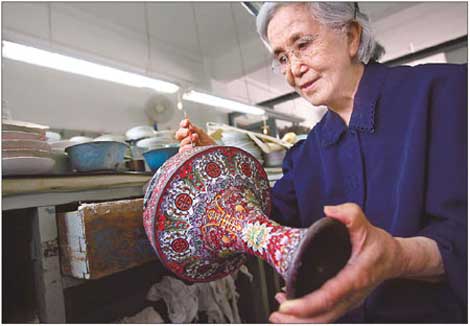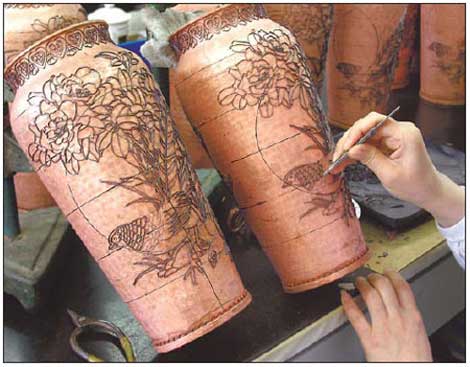Art of saving vase
Updated: 2011-06-17 12:03
By Wu Wencong (China Daily European Weekly)
 |
|
Zhang Li from the Beijing Enamel Factory puts the finishing touches on a cloisonne enamelware vase. |
Revealing the multi-step process of making world famous Chinese pottery
Few people would disagree that the craft most representing China's glorious Ming Dynasty (1368-1644) is cloisonn?enamelware. The iconic Chinese artwork, which requires more than 100 steps to finish, used to be recognized as something reserved for nobility, not only because of the complicated manufacturing process, but also because of its price.
Considering the cost of pure gold and the amount of copper wire used, these precious handicrafts were out of reach of ordinary folk.
Craftsmen say it takes about three months to finish a vase only 15 centimeters high; pieces as tall as 1 meter take much longer.
"There are roughly six major steps," says Zhang Li, a staff member of the Beijing Enamel Factory, the most famous brand in this industry.
"The most important one is the second, pinching copper wire, which is the first thing we do in our factory."
The first step is making the base, which includes welding copper boards into the desired shape. This is done outside the factory.
Pinching copper wire requires drawing the patterns on the copper base, then shaping copper wires into the patterns using tweezers, and finally pasting the wires onto the base. After this step is completed, patterns appear in 3D.
The next process is called filling enamel, which produces the different colors on an object.
Using burettes, a vertical cylindrical piece of glass, craftsmen dip them into the right color and then carefully apply the liquid into the right position. On some pieces, at least three or four layers of coloring are required.
The vase is also burned between each layering of coloring in order to get rid of the frosted-looking surface, leaving it bright and shiny.
Judging by its Chinese name, JingTai Blue, some may think cloisonn works only come in blue. Although blue is a dominant color used in these popular works, it is not the only one.
Local artisans produced China's first enamelware works during the Yuan Dynasty (1270-1368) but in the time of the Ming Dynasty, the technique of cloisonn enamelware became more refined, especially during the reign of Emperor Zhu Qiyu, also called Jingtai, hence the title Jingtai Blue.
Connoisseurs of Chinese cloisonn enamelware say pieces made during the Jingtai period are considered to be the world's best.
 |
|
The pinching copper wire process requires drawing the patterns on the copper base, then shaping copper wires into the patterns using tweezers, and finally pasting the wires onto the base. Provided to China Daily |
During this time, kiln operators investigated new firing techniques and artists experimented with design and shape, showing a predilection for color and painted design. Today, a quality Ming vase can fetch millions at auctions.
During the Qing Dynasty in 1893, during the reign of Emperor Qianlong, Chinese cloisonn enamelware won first prize at the World's Fair in Chigago. In 1915, this form of pottery won first prize at World's Fair in San Francisco, another international event where Chinese craftsmen gained fame throughout the world.
At that time, these items became popular luxury gifts.
At first, artists made bowls, vases and delicate ornaments such as rings but with the improvement of techniques cloisonn enamelware featured in furniture, such as desks and screens.
Later, traditional brush drawings were often painted on products creating a special Chinese charm.
Over the centuries, colors used for cloisonn were only generated from natural crystal, which is ground into powder and mixed with water.
But as all colors other than blue need added gold to be visible, craftsmen had little choice but to make items mostly in blue.
After burning the colored works, they all look much like the finished product, apart from their rough surface and red lines, as copper turns red after burning.
So the next two steps are polishing and gilding.
Charcoal made of basswood is used in the polishing process to burn the surface of the cloisonn again. Then 24-carat gold is gilded over all the copper lines.
"The cost of copper, gold and irreplaceable manual skills together set the threshold of cloisonne's price," says Zhang.
Despite its lofty status in Chinese culture, the craft actually originated in Egypt, a fact recorded in an ancient Chinese book called Ge Gu Yao Lun (Essential Criteria of Antiquities), published in 1388.
Over the centuries, the 108 steps in making cloisonn were passed down to generations of craftsmen through word of mouth without any written rules or guidelines. It wasn't until 1958, when Qian Meihua, one of the six most prestigious cloisonn designers in China, decided to devote herself to this craft.
Born in 1927, she committed her life to preserving the craft of Chinese cloisonn enamelware. She participated in the design work of China's gifts to the Asia-Pacific Peace Conference and her cloisonn enamelware desk lamp design was one of the first state presents of the People's Republic of China.
Qian passed away in March last year at the age of 83.
In June, the Beijing Enamel Factory, where she had worked for more than 50 years, will hold an exhibition dedicated to her designs. Thirty-six items will be on display, 30 of which were made in recent years.
From the 1960s to the 1980s, Qian designed most of the works on the theme of the "cultural revolution" (1966-76).
One of the most intersting works is a two-meter-tall vessel titled Peace that is beautifully enscribed with colorful flowers and birds. This was her last work.
"The exhibition marks one of the factory's developing areas: high-end works of value for collectors," says the factory's board chairman, Yi Fucheng, who was a polisher back in the 1970s when he first came to the factory.
Yi says his factory is now combining the traditonal craft with modern architecture or interior designs.
He says these new efforts include making large outdoor fountains, or small containers for tea and Chinese liquor. "Applying the intangible heritages to daily life is better for their protection than simply making something beautiful but useless," Yi says.
E-paper

Ringing success
Domestic firms make hay as shopping spree by middle class consumers keeps cash registers ringing in Nanjing
Mixed Results
Crowning achievement
Living happily ever after
Specials

Ciao, Yao
Yao Ming announced his retirement from basketball, staging an emotional end to a glorious career.

Going the distance
British fitness coach comes to terms with tragedy through life changes

Turning up the heat
Traditional Chinese medicine using moxa, or mugwort herb, is once again becoming fashionable
